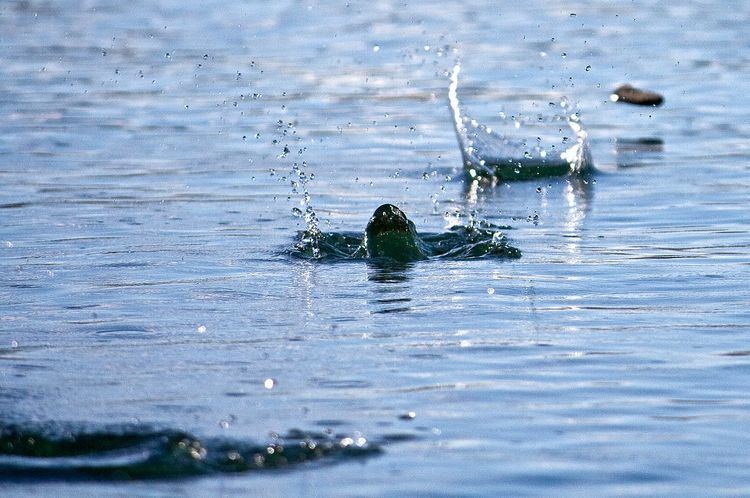 | ||
Stone skipping is the pastime of throwing a flat stone across water in such a way that it bounces off the surface, preferably many times. The object of the game is to see how many times a stone can bounce before sinking.
Contents
Championships and records
The North American Stone Skipping Association (NASSA), founded by Coleman-McGhee, in 1989 and based in Driftwood, Texas, sanctioned world championships for four years from 1989 through 1992 in Wimberley, Texas. The next official NASSA World Championships is expected to be held at Platja d'en Ros beach in Cadaqués, Catalonia, Spain.
The world record for the number of skips Guinness Book of Records is 88 by Kurt "Mountain Man" Steiner, age 48. The cast was achieved on September 6, 2013 at Red Bridge in the Allegheny National Forest, Pennsylvania. The previous record was 65 skips, by Max Steiner, set at Riverfront Park, Franklin, Pennsylvania. Before him, the record was 51 skips, set by Russell Byars on July 19, 2007, skipping at the same location. Kurt Steiner also held the world record between 2002 and 2007.The US Stone Skipping champion 2016 at Franklin was Dave Ohmer (Titusville PA) with 40 skips.
A stone skipping (aka stone skimming) championship of a different nature takes place every year in Easdale, Scotland, where distance is measured as opposed to number of skips, as tends to be the case outside the US. Since 1997, competitors from all over the world have taken part in the World Stone Skimming Championships in a disused quarry on Easdale Island, using sea-worn Easdale slate. The stone must bounce/skip at least three times to count. Historical results are available on www.stoneskimming.com. Dougie Isaacs (Scotland) won the title again in 2016, so accruing the most titles in the competition's history (8).Other current title holders include Lucy Wood (England) World Ladies ; Coerd de Heer (Netherlands),European (last held October 2015); Jolien Eshuis (Netherlands) European Ladies (last held October 2015); Ron Long (Wales), All England; Gary Bailey (England) British; Richard Struthers (Wales), Wales Open. The above events require use of natural stone only except for the Wales.The world record for distance skimmed using natural stone was laser-surveyed at 107.4 metres (352.3 ft), at a Guinness-endorsed event comprising a select squad of 12 and held for the purpose at Abernant Lake, Llanwrtyd Wells, Powys, Wales on Monday 30 May 2016. The throw was by Dougie Isaacs.
Scientific explanation
An early explanation of the physics of stone-skipping was provided by Lazzaro Spallanzani in the 18th century.
The stone generates lift in the same manner as a flying disc, by pushing water down as it moves across the water at an angle. Surface tension has very little to do with it. The stone's rotation acts to stabilize it against the torque of lift being applied to the back.
Research undertaken by a team led by French physicist Lydéric Bocquet discovered that an angle of about 20° between the stone and the water's surface is optimal. Bocquet and his colleagues were surprised to discover that changes in speed and rotation did not change this fact. Work by Hewitt, Balmforth and McElwaine has shown that if the horizontal speed can be maintained skipping can continue indefinitely. Earlier research reported by Bocquet calculated that the world record of 38 rebounds set by Coleman-McGhee, unchallenged for many years, required a speed of 12 m/s (25 mph), with a rotation of 14 revolutions per second.
